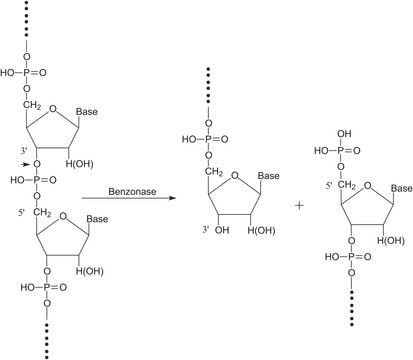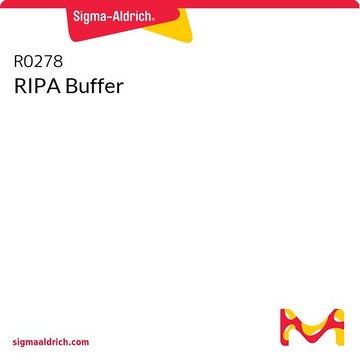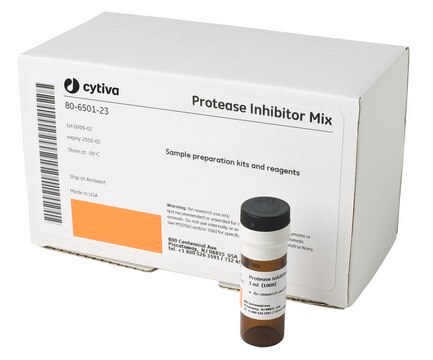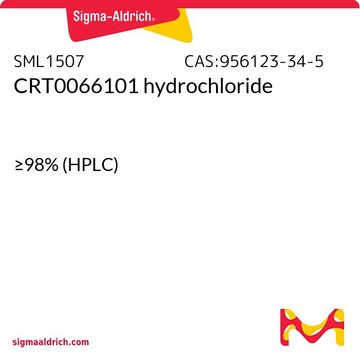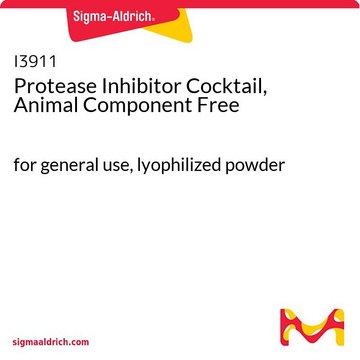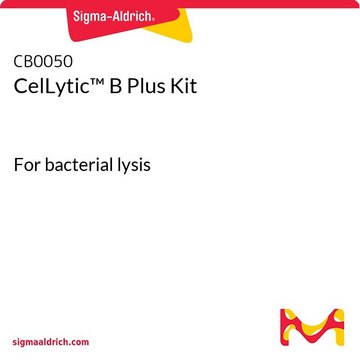P8849
Protease Inhibitor Cocktail
DMSO solution, for the inhibition of serine, cysteine, aspartic, aminopeptidases and thermolysin-like activities, for use in purification of Histidine-tagged proteins, DMSO solution
Sinónimos:
Protease inhibitor solution
Iniciar sesiónpara Ver la Fijación de precios por contrato y de la organización
About This Item
Productos recomendados
Nombre del producto
Cóctel de inhibidores de proteasas, for use in purification of Histidine-tagged proteins, DMSO solution
origen biológico
synthetic
Nivel de calidad
Formulario
DMSO solution
solubilidad
water: soluble
temp. de almacenamiento
−20°C
¿Está buscando productos similares? Visita Guía de comparación de productos
Descripción general
DMSO solution designed for use in the purification of histidine-tagged proteins.
The cocktail contains a mixture of inhibitors that specifically target serine, cysteine, aspartic, and thermolysin-like proteases, and aminopeptidases.
The cocktail contains a mixture of inhibitors that specifically target serine, cysteine, aspartic, and thermolysin-like proteases, and aminopeptidases.
Especificidad
Inhibits serine, cysteine, aspartic, and thermolysin-like proteases, and aminopeptidases.
Aplicación
The cocktail has been optimized and tested for isolation of histidine-tagged proteins, with chelating agents omitted for compatibility with IMAC applications.
It is recommended for inhibition of protease activity in 100 mL of cell lysate from 20 g of Escherichia coli or 10 g of baculovirus-infected Spodoptera frugiperda pupal ovary cells.
It is recommended for inhibition of protease activity in 100 mL of cell lysate from 20 g of Escherichia coli or 10 g of baculovirus-infected Spodoptera frugiperda pupal ovary cells.
Características y beneficios
Specifically formulated for histidine-tagged protein purification.
Targets multiple types of proteases, ensuring comprehensive inhibition of protease activity.
Compatibility with IMAC applications due to omission of chelating agents.
Supplied in convenient packaging options.
Targets multiple types of proteases, ensuring comprehensive inhibition of protease activity.
Compatibility with IMAC applications due to omission of chelating agents.
Supplied in convenient packaging options.
Componentes
AEBSF
Bestatin
E-64
Pepstatin A
Phosphoramidon
Bestatin
E-64
Pepstatin A
Phosphoramidon
Cantidad
One mL is recommended for the inhibition of proteases extracted from 20 g of Escherichia coli or 10 g of baculovirus-infected Spodoptera frugiperda pupal ovary cells in a total volume of 100 ml.
This protease inhibitor cocktail has been optimized and tested for histidine-tagged proteins
This protease inhibitor cocktail has been optimized and tested for histidine-tagged proteins
Nota de preparación
This product is supplied as a clear solution in DMSO. One mL of solution is recommended for inhibition of protease activity in 100 mL of cell lysate from 20 g of E. coli cells or 10 g of baculovirus-infected cells.
Producto relacionado
Referencia del producto
Descripción
Precios
Código de clase de almacenamiento
10 - Combustible liquids
Clase de riesgo para el agua (WGK)
WGK 1
Punto de inflamabilidad (°F)
185.0 °F - closed cup
Punto de inflamabilidad (°C)
85 °C - closed cup
Elija entre una de las versiones más recientes:
¿Ya tiene este producto?
Encuentre la documentación para los productos que ha comprado recientemente en la Biblioteca de documentos.
Los clientes también vieron
C Rivier et al.
The EMBO journal, 20(7), 1765-1773 (2001-04-04)
In Chlamydomonas reinhardtii, the psaA mRNA is assembled by a process involving trans-splicing of separate transcripts, encoded at three separate loci of the chloroplast genome. At least 14 nuclear loci and one chloroplast gene, tscA, are needed for this process.
Intracellular Nogo-A facilitates initiation of neurite formation in mouse midbrain neurons in vitro.
Z Kurowska et al.
Neuroscience, 256, 456-466 (2013-10-26)
Nogo-A is a transmembrane protein originally discovered in myelin, produced by postnatal CNS oligodendrocytes. Nogo-A induces growth cone collapse and inhibition of axonal growth in the injured adult CNS. In the intact CNS, Nogo-A functions as a negative regulator of
Shuji Kaneko et al.
The Journal of neuroscience : the official journal of the Society for Neuroscience, 22(1), 82-92 (2002-01-05)
The physical interaction between the presynaptic vesicle release complex and the large cytoplasmic region linking domains II and III of N-type (Ca(v)2.2) calcium channel alpha(1)B subunits is considered to be of fundamental importance for efficient neurotransmission. By PCR analysis of
Shahar Rotem-Bamberger et al.
PloS one, 8(3), e58470-e58470 (2013-03-09)
ASPP2 is a key protein in regulating apoptosis both in p53-dependent and-independent pathways. The C-terminal part of ASPP2 contains four ankyrin repeats and an SH3 domain (Ank-SH3) that mediate the interactions of ASPP2 with apoptosis related proteins such as p53
E Boudreau et al.
The EMBO journal, 19(13), 3366-3376 (2000-07-06)
The psbD mRNA, which encodes the D2 reaction center polypeptide of photosystem II, is one of the most abundant chloroplast mRNAs. We have used genomic complementation to isolate the nuclear Nac2 gene, which is required for the stable accumulation of
Nuestro equipo de científicos tiene experiencia en todas las áreas de investigación: Ciencias de la vida, Ciencia de los materiales, Síntesis química, Cromatografía, Analítica y muchas otras.
Póngase en contacto con el Servicio técnico







